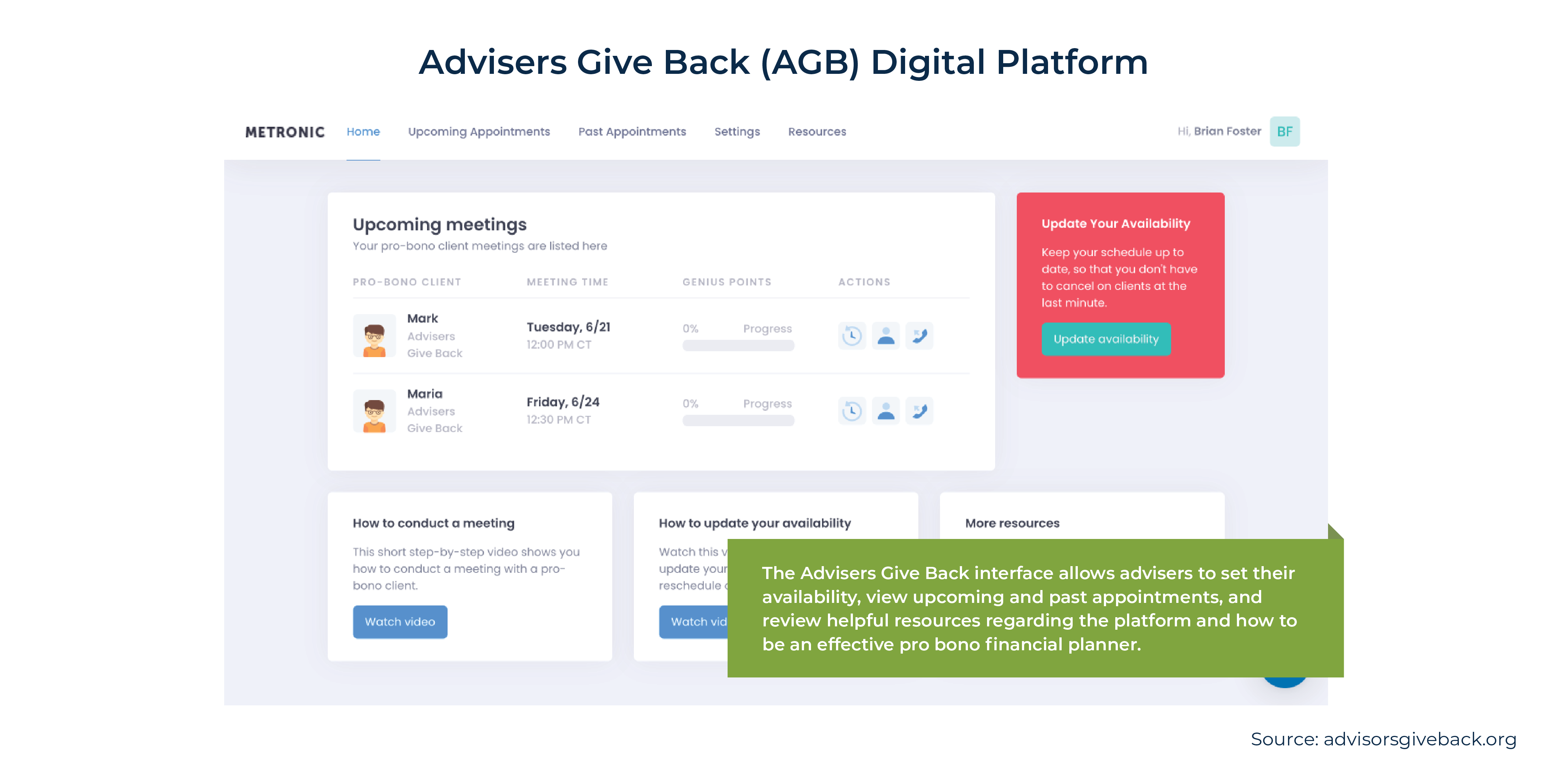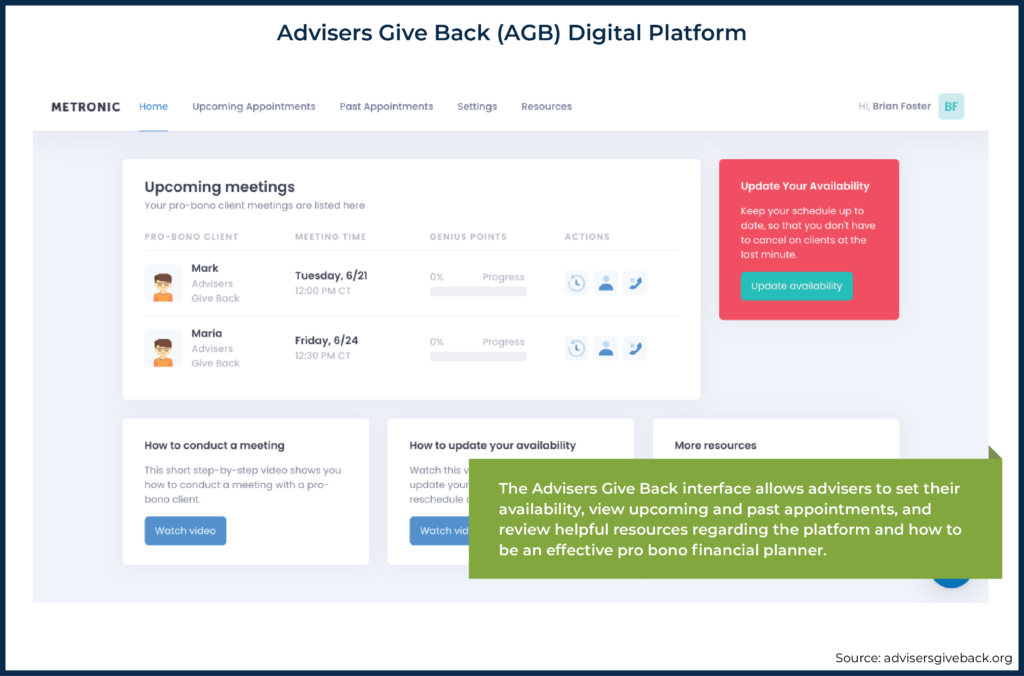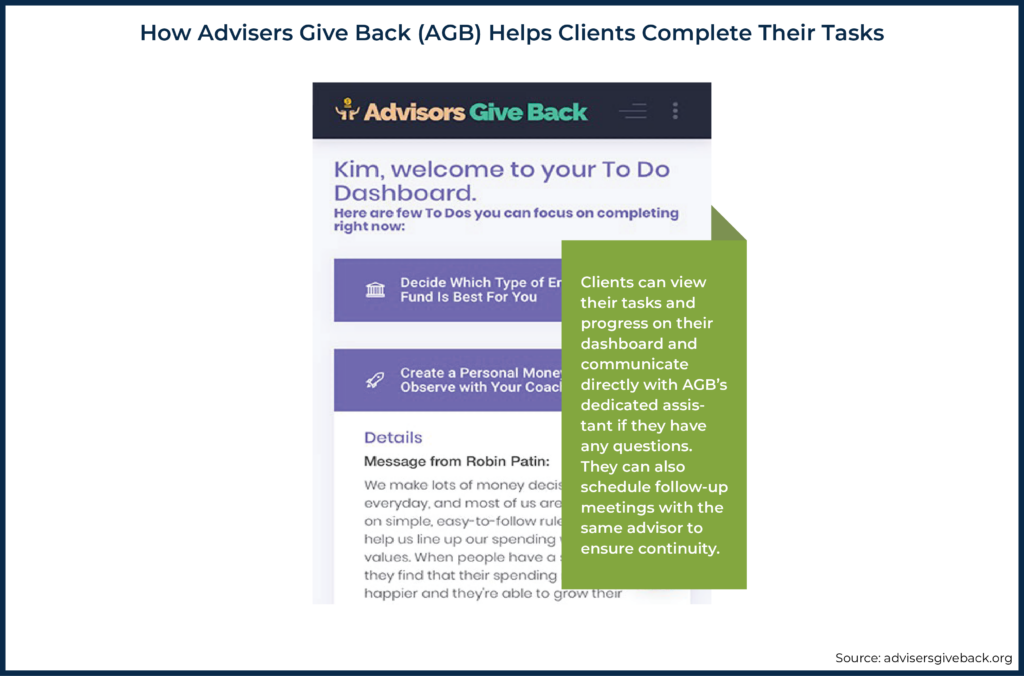Executive Summary
Working as a financial advisor can be both financially rewarding and emotionally satisfying. By helping clients develop financial goals, creating a financial plan, and supporting the implementation and monitoring of the plan, advisors help clients live their best lives. But while new fee models have allowed fee-only advisors to reach an expanding range of potential clients, there are many Americans who could benefit from professional financial advice but might not have sufficient income or assets to pay for it. This gives advisors the opportunity to offer their services on a pro bono basis, and the Advisers Give Back platform allows them to do so in as little as one hour per month.
Pro bono financial planning refers to free, no-strings-attached financial advice and planning for underserved people. Most advisors are already familiar with many of the issues these individuals face, from setting goals to debt management, although the specifics might be slightly different given the typically lower incomes and wealth of pro bono clients. In addition to providing a valuable service to the community and serving as a meaningful activity for advisors, pro bono planning is also an important part of growing financial planning into a profession, similar to other fields (e.g., law) with established pro bono programs. Further, pro bono planning can help advisors develop their skills, whether it is working with individuals of different ages or incomes than their usual clients to practicing their empathetic listening and client meeting skills (which is especially relevant for more junior advisors whose primary functions may be focused on back office responsibilities supporting senior advisors, and who might not have as many opportunities for substantive one-on-one client interactions!).
Given the demands from running (or working for) an advisory firm as well as the time needed to research ways to offer pro bono planning, the non-profit group Advisers Give Back (AGB) has created a platform that allows advisors to participate in pro bono planning for as little as one hour per month. AGB allows advisors to meet with clients and develop recommendations while significantly reducing the potential friction involved in getting started with pro bono planning. For instance, AGB connects with pro bono clients so advisors do not need to spend time advertising their services.
Any advisor with the CFP certification can use the AGB platform after completing an online, 60-minute training session, after which advisors can set their availability for pro bono client meetings. The AGB platform facilitates multiple meetings with the same pro bono clients, allowing advisors to build relationships with their clients and to track their progress, so that both short-term stressors and long-term goals can be addressed. AGB also offers dedicated assistants who help with administrative tasks, communicating with clients and tracking their progress between meetings, which saves advisors even more time.
Ultimately, the key point is that the Advisers Give Back (AGB) platform allows busy advisors to engage in pro bono planning in as little as one hour per month. Which is important, because even though volunteering can offer advisors the personal satisfaction of offering a valuable service to the community, participating in pro bono opportunities is also a vital part of the business of financial advice itself becoming a recognized profession, and is an important contribution to the growth of financial planning as well!
Working as a financial advisor provides the opportunity for a career that is not just financially rewarding, but emotionally satisfying as well. By helping clients develop financial goals, creating a financial plan, and supporting the implementation and monitoring of the plan, advisors help clients live their best lives, while in the process of generating their own revenue to support their own lifestyles.
While new fee models have allowed fee-only financial advisors to reach an expanding range of potential clients, there remain a large number of Americans who cannot be profitably served due to low income and/or assets. While their financial issues may differ in some respects from ‘traditional’ financial planning clients, they can still stand to benefit greatly from the services of experienced advisors to help them with setting goals, managing cash flow and debt, and creating a plan to increase their wealth into the future. Which is where pro bono financial planning comes in, giving advisors the opportunity to volunteer their time to serve these clients, and using the Advisers Give Back (AGB) platform allows them to do so in as little as one hour per month!
What Is Pro Bono Financial Planning And Why Is It Important?
While advisors might have a general idea of what it means to engage in pro bono financial planning, it is important to specify the types of clients served and the services offered, so that both advisors and clients know what to expect from the engagement. To that end, CFP Board, the Financial Planning Association (FPA), the National Association of Personal Financial Advisors (NAPFA), and the Foundation For Financial Planning (a non-profit that promotes pro bono financial planning) created a shared definition of pro bono financial planning to guide advisor pro bono activities:
Free, no-strings-attached financial advice and planning for underserved people provided by or in conjunction with a CFP professional volunteer. These services will be delivered through one-on-one engagements or through interactive group sessions on topics specific to an at-risk audience, with the option for personalized engagement to follow.
This definition demonstrates the broad range of potential pro bono clients and the different ways they can be served. For example, an advisory firm could carve out one day each quarter for its advisors to meet with low-income individuals in their community, or an advisor could offer group sessions to small groups of service members and their families on relevant financial planning topics. Importantly, the definition notes that pro bono planning is to be provided on a “no-strings-attached” basis, so that pro bono clients do not feel obligated to engage in any paid services with their advisor.
Common Issues Faced By Pro Bono Clients
One of the benefits of working as a financial advisor is that clients have unique situations and issues to work through, creating an interesting variety in the day-to-day workflow. And pro bono clients are no different, with a range of experiences and planning opportunities for an advisor to work through.
Many of the issues pro bono clients face are similar to those of traditional financial planning clients, even if the scale of their relative net worth amounts is different. As a 2020 Morningstar Advisor Insights article points out, “Providing high-quality pro bono services means treating pro bono clients like you would treat any other client.” For example, the first step of the CFP Board’s 7-step financial planning process, to understand the client’s personal and financial circumstances, can apply to any client. Just like a traditional client who might need guidance in gathering all of the documents to assess their net worth and cash flow, a pro bono client might also need similar guidance. It can also be helpful for both pro bono clients and traditional clients to access their credit reports to help them (and their advisors) understand their credit history and correct any mistakes they may find in their reports.
In addition to helping pro bono clients organize the details of their financial lives, advisors also can help them identify and select goals. While pro bono clients sometimes will be (appropriately) focused on short-term stressors, working on establishing longer-term goals can help them see the bigger picture of their finances and encourage them to take a forward-looking approach.
At the same time, pro bono clients often face a range of issues an advisor might not deal with regularly in their business. For example, a pro bono client might have lost their job and may not know how they will pay their rent the following month. Another client might have a significant debt load and might need assistance prioritizing the limited amount of money they have available to pay it off. In fact, some advisors can choose to have a pro bono niche where they have expertise in issues facing certain types of pro bono clients (e.g., military veterans or single parents); though, broadly, many of the skills honed in the advisory business (e.g., empathetic listening and best practices for cash flow management) are applicable to pro bono clients as well.
Why Pro Bono Planning Is Important
Given the significant value of sound financial advice, pro bono planning allows advisors to reach a wider range of individuals to help them thrive financially, beyond the typical (limited) base of clients who can afford to engage with a financial planner. While there are many kinds of fee structures for fee-only advisors, clients typically either need a certain minimum amount of investible assets (for advisors charging on an AUM basis) or enough income to pay a retainer or hourly fee (and even clients of commission-based advisors need to have some investible assets on which the advisor can earn a commission). Pro bono financial planning, though, allows individuals who wouldn’t normally be able to afford to hire a financial advisor to still reap the benefits of working with a qualified professional, regardless of their financial status.
In addition, pro bono planning is an important part of growing financial planning into a profession, similar to lawyers and accountants who have established pro bono programs. As the financial advisory industry transitions from a focus on product sales to offering unbiased advice, a growing and recognized pro bono program can help boost the public’s perception of advisors and the industry as a whole.
Further, participating in pro bono financial planning not only helps pro bono clients, but benefits advisors as well. First, engaging in pro bono planning can be a meaningful activity for advisors looking to improve the lives of those with less income or in trying circumstances. Second, pro bono work can expose an advisor to clients with different characteristics (e.g., age, income level) and issues from those they are accustomed to working with in their firms, potentially broadening their awareness of the issues individuals face and improving their communication skills. And lastly, especially relevant for more junior advisors, pro bono planning can provide valuable client-facing experience that might be harder to get in the office as they advance at their firm.
The key point is that pro bono financial planning can offer advisors the opportunity to make a difference in the lives of individuals who might not otherwise be able to access planning services. And the benefits of pro bono planning extend beyond the clients themselves to the planners who offer their services, as well as the financial advice industry as a whole!
How Advisers Give Back (AGB) Facilitates Pro Bono Planning For Financial Advisors
Many advisors are aware of the various benefits of pro bono financial planning, but getting started can feel like a challenge. Given the demands of running (or working for) an advisory firm as well as the time needed to research ways to volunteer (or offer pro bono within the firm), some advisors feel they have the desire but lack the time to engage in pro bono planning. With this in mind, the non-profit group Advisers Give Back (AGB) has created a platform (thanks in part to generous donations) that allows advisors to participate in pro bono planning for as little as one hour per month.
AGB allows advisors to do what they do best – meet with clients and develop recommendations – while significantly reducing the potential friction involved in getting started with pro bono planning. For instance, AGB connects with pro bono clients so advisors don’t need to spend time advertising their services. In addition, conversations between advisors and clients with AGB are conducted remotely through the AGB dashboard, which can be more convenient for advisors (who do not have to spend time traveling to a volunteer site) and creates a wider pool of potential clients (who can meet with an advisor regardless of where they live). And for advisors with potential liability concerns from pro bono planning, AGB has an Errors and Omissions insurance policy that covers advisors when they are providing pro bono services on the platform.
Client meetings on the AGB platform are typically scheduled for 20 minutes, so an advisor can have multiple meetings each hour they make themselves available on the platform. Clients fill out intake surveys in advance, answering questions regarding their background and goals, so advisors can take a few minutes to review them beforehand. This allows the meeting discussion to focus more on developing recommendations and action items and less on initial discovery. Further, the remote meeting system is designed for the advisor and their client to select and record action items during the meeting so the advisor does not have to spend significant time on follow-up after the meeting.
Another benefit of the program is that AGB lets advisers choose the dates and times they are available to meet with pro bono clients, so that advisors have maximum flexibility based on their work and personal schedules. The platform offers appointments seven days a week, so advisors who cannot carve out time during the workday or in the evening can still offer their services. Even if it is just one hour per month, advisors can still take advantage of the opportunity to offer pro bono planning.
For those advisors who have participated in pro bono planning in the past, a frequent concern is that they are often only able to meet with the client a single time. Because while advisors and pro bono clients can make some progress in a single meeting, pro bono programs often don’t accommodate follow-up meetings with the client for the advisor to see if they implemented the recommendations or to make adjustments to the action items if necessary.
But the AGB platform makes it easy for advisors and pro bono clients to meet multiple times. This allows the advisor to build a relationship with the client, track their progress, and potentially help the client not just with short-term stressors, but also with long-term goals, which can potentially make the engagement more meaningful for the advisor and also more effective for clients (who don’t have to explain their situation to a new advisor each time they receive pro bono services).
Another way AGB facilitates the pro bono planning process is through their dedicated assistants, who serve as intermediaries between an advisor and their clients. For example, an advisor might give a client several action items to complete before their next meeting. Instead of hoping that the clients complete the to-do items or sending a reminder themselves, the assistants follow up directly with the clients on their key tasks and update the advisors on their progress. This not only saves the advisor time but also encourages clients to complete their recommended action items.
Example 1: Patty is a pro bono financial planner with Advisers Give Back (AGB) and is meeting with a new client, Carly, for the first time. Patty spends five minutes before the meeting reviewing Carly’s intake form to learn about her financial situation and goals. During the meeting, Patty and Carly decide that Carly’s first action item is to open a savings account and deposit $100 to start an emergency fund.
Carly schedules a follow-up meeting with Patty four weeks later through the AGB platform. Two weeks before the meeting, Carly receives a reminder from AGB that she still needs to complete her task to open a savings account. Before the meeting, AGB confirms both that Carly completed her task and will be attending the second meeting, where Patty and Carly can move on to new issues and action items.
Thanks to the AGB platform, this entire engagement – including scheduling, meeting, and client follow-up to ensure she completed her action item – took less than 30 minutes of the advisor’s time.
Together, the dedicated assistants and the potential for multiple (free) meetings with the advisor make it less likely that a client will get ‘stuck’ on a task that impedes them from following through on the rest of their plan, as the client and advisor have the option to set a workable pace that is comfortable and realistic for the client. Instead, the client has multiple points of contact where they can find an answer. This combination of incremental tasks for clients to complete, reminders from the AGB assistants, and the potential for multiple meetings with the same advisor makes it more likely that the client will follow through with the plan they have designed with their advisor.
Altogether, AGB makes it easy for even the busiest advisors to engage in pro bono planning. And its use of multiple advisor-client meetings and dedicated assistants can create more meaningful interactions between advisors and clients and helps keep clients on track to achieve their financial goals!
How Advisors Can Get Involved With Advisers Give Back (AGB) And Make The Most Of Their Pro Bono Experience
In addition to facilitating meetings between advisors and pro bono clients, Advisors Give Back (AGB) makes it easy to get started on their platform. And once an advisor is up and running, they can take steps to ensure that they provide a quality experience for their clients and make pro bono service a regular part of their schedule.
Any advisor with the CFP certification can sign up to offer pro bono planning services on the Advisers Give Back (AGB) platform. The first step of the sign-up process is to complete an online application, which takes about 10 minutes. The advisor then attends an online, 60-minute training session that shows them how to schedule their availability on the AGB platform, take part in client meetings, and work with the dedicated assistants to record and track client tasks. After completing the training, advisors can set their availability on the platform and await appointments with pro bono clients to be scheduled (and don’t forget to have a good headset available to ensure clear audio on the calls)!
In addition to the AGB platform training, advisors can also consider taking the free, one-hour training course for pro bono financial planning volunteers created by the Foundation for Financial Planning and Kaplan Financial Education. The course is designed to give advisors the skills and techniques to address the specific needs of lower-income families. In addition, advisors who view the course and pass a self-assessment can receive 1 hour of Continuing Education (CE) credit required of CFP professionals!
Sticking To A Pro Bono Planning Schedule
Finding time in busy advisor schedules is one of the challenges of engaging in pro bono financial planning on an ad hoc basis. This is why many Financial Planning Association (FPA) chapters and other advisor groups create ‘financial planning days’ each quarter or year so that advisors can block their calendars well in advance for the event.
Similarly, AGB allows advisors to plan ahead by setting up the dates and times they are available for pro bono planning. In this way, an advisor can block their calendar to ensure they have time available for their pro bono planning engagements. And while advisors have the option of marking themselves as unavailable on certain dates (e.g., if they are on vacation), committing to the same time every week or month reduces the friction of coordinating different times for each pro bono session.
Notably, an advisor who marks themselves as available during a certain day and time will not necessarily have an appointment scheduled during that period. The AGB platform notifies advisors when there is an appointment scheduled; in addition, the platform re-confirms the appointment with the client and lets the advisor know 24 hours in advance whether the meeting is confirmed. With this system, advisors can be more confident that clients will attend the scheduled meeting and lets them know if they can go back to their other responsibilities if there is no meeting scheduled.
And while an individual advisor can make a significant impact through pro bono planning, the benefits are magnified when several advisors join together. For example, advisory firms could make it an established part of company culture for their advisors to dedicate one hour per week (or another amount of time) to pro bono planning.
Example 2: Friendly Financial Advisors (FFA) wants to start a pro bono program for its 5 advisors but doesn’t have the time or resources to set up a program on its own.
Instead, FFA encourages each of its 5 advisors to volunteer for 1 hour per week throughout the year on the Advisers Give Back platform. This way, the firm’s advisors could complete up to 5 advisors × 1 hour per week × 52 weeks = 260 hours of pro bono planning offered by the firm each year!
In addition to its convenient scheduling features, AGB has created a program specifically designed for local FPA chapters to make it easy for chapter members to engage in pro bono planning and for the chapter to record its total hours throughout the year. Another benefit of the affiliation with FPA chapters is that the platform can match advisors with pro bono clients in their chapter’s geographic area. Having advisors offer pro bono planning remotely through AGB can also be an excellent complement for FPA chapters’ in-person financial planning days that bring their members together in person.
Ultimately, the key point is that the Advisers Give Back (AGB) platform allows busy advisors to engage in pro bono planning in as little as 1 hour per month. And with its virtual platform and dedicated assistants, advisors can spend more time working directly with clients and less time on administrative tasks. Further, with the ability to meet with a client multiple times, advisors can see clients make significant progress toward their financial goals.
In the end, volunteering with AGB can offer much more than just the advisor’s personal satisfaction of offering a valuable service to the community; because pro bono financial planning is an important part of the business of financial advice itself becoming a recognized profession, it is also an important contribution to the growth of financial planning as well!






